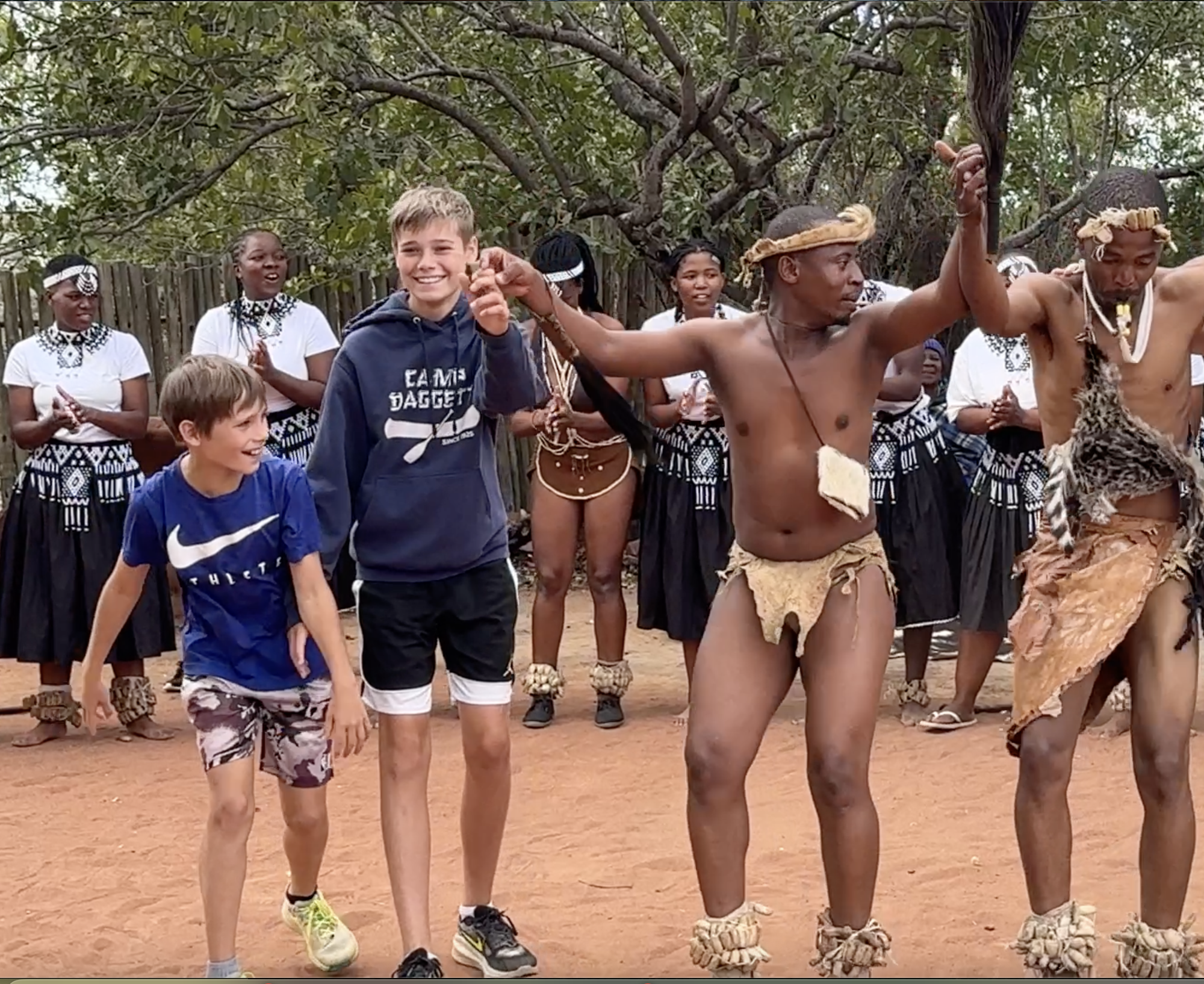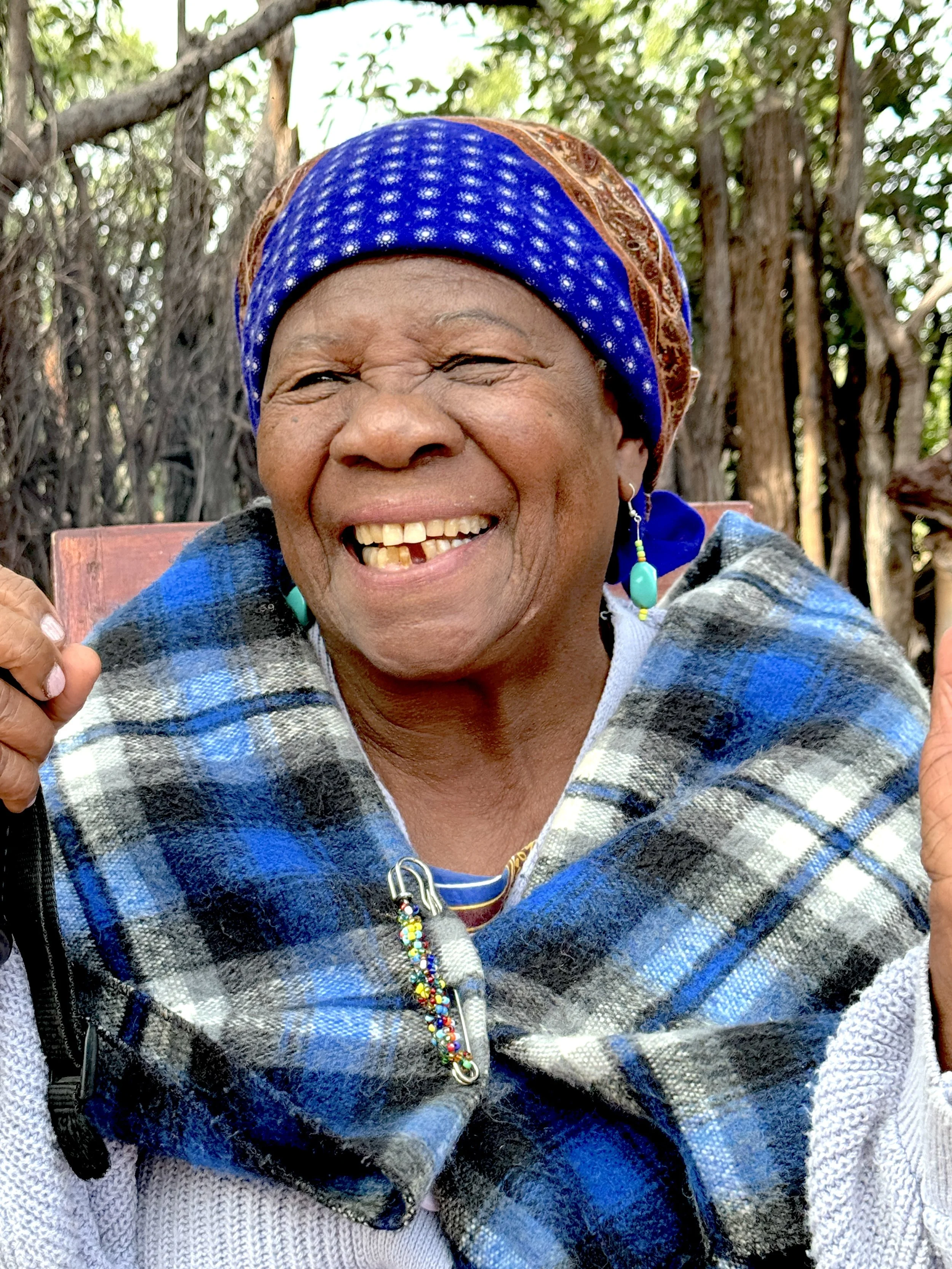How Do You Pass Down a Vanishing Way of Life?
Visiting a Botswana elder who built a living classroom to keep her culture alive.
It’s easy to forget, when you live here, that much of the world still imagines Africa in sepia tones; endless plains, tribal chants, noble poverty. Botswana (along with many other places on the continent) doesn’t fit that picture. It’s modern, steady, pragmatic; you can transfer money by phone, then drive past a donkey cart on the shoulder. Office towers and cattle posts share the same horizon.
And yet, beneath that modern order runs something deeper. A quiet current of continuity. The country’s stability, its enviable peace, didn’t come from nowhere. It comes from the same wisdom that once gathered people beneath a tree to talk things through. The question is: how does a nation racing into the future protect the traditions that built it?
That’s what brought us to Bahurutshe Cultural Village, an hour from the city, on the edge of Mmankgodi. My parents were visiting, and we all wanted to learn more about the stories and customs that shape Botswana. Not the safari brochures, but the heartbeat underneath.
Stepping Into Another Rhythym
Before we’d even unbuckled, the Bahurutshe courtyard burst into motion. Women in leteisi welcomed us with a bright volley of ululation - lelelele! - the kind of greeting you feel in your spine. (We hear the same trilling all over Botswana: at school concerts, office milestones, even Peace Corps swearing-in ceremonies. It’s a sound that says, there is joy in this moment we’re experiencing together.)
During the dances, Ben, Emory and Kris were spotted and swept into the first dance (no place to hide!), bodies reluctantly mimicking a circle of high steps and flying hands. In Botswana, dance isn’t performance for its own sake; it’s a kind of language. Movements mark milestones, honor ancestors, celebrate harvests, and bind the group into one rhythm. Every stomp, clap, and whistle says things words can’t.
After the welcome came more learning: homes built from earth and grass; how sorghum is pounded; how food, healing, and farming used to fit together as a single system of life. My mom was handed a long wooden pestle and fell into a steady rhythm while the women led a work song that set the pace.
One of the elders explained that women sang while grinding, weeding, fetching, and walking because song keeps time and keeps people together. Music wasn’t background; it organized moments, welcoming visitors, marking weddings, mourning losses, and celebrating the ordinary.
“What inspired me to start this was seeing the younger generation losing our culture. I thought I must create a place where they can come and learn what they no longer understand. ”
Heritage in Her Hands
Mmankudu Norah Glickman, founder of Bahurutshe Cultural Village
When I asked our 85-year-old host, Mmankudu Norah Glickman, what sparked this place, she didn’t hesitate.
“What inspired me to start this was seeing the younger generation losing our culture. Back in 1996, I thought: no, it’s time. I must create a place where they can come and learn what they no longer understand. The schools can bring them here so they can see our traditions for themselves, not just hear about them.”
She talked about growing up when remedies came from the land and knowledge came from watching.
“When I was a girl, our elders used herbs for healing. Everything came from the land. There were no clinics then. People used what they had: smoke for a headache, herbs for fever, even cow dung mixed with milk for a snake bite. It sounds terrible, but it worked. These were lessons you didn’t read in a book, you learned by watching.”
That watching, that apprenticeship of living, is what she’s trying to preserve. What she’s built isn’t a museum. It’s participatory. Schools bus in students. Travelers come, yes, and there’s performance, but the point is the continuity of skills and stories staying in circulation.
Youth + Continuity
A study on cultural tourism in Botswana calls this “rejuvenation of culture” where young people are finding a “future in their own past” and the work is community-led and often led by women. Watching the teenage dancers, you can see it: pride first, livelihood second, and then the wider circle for teaching others.
“The young ones come here because they know this is their future,” she told me. “They dance, they learn, and they earn a living, too. My daughter—her name is Dubu—has already taken over the storytelling. So even when I go, it will live on.”
That’s the through-line: not freezing history, but giving it new carriers.
Under the Leobo
We moved to the leobo, the open-air thatched shelter that serves as a meeting place. We sat, and she told a story her mother told her: about a young antelope who ignored the warnings of its elders. Restless and proud, it wandered too far from the herd, certain it was fast enough to outrun anything. But when the lions came, speed wasn’t enough. Only the dust rose where the young one had been, and the herd stood in silence, learning the lesson.
Storytelling (mainane) is more than entertainment here. Traditionally it happened in the evenings, often led by grandmothers, and it carried the moral code of the community through jokes, songs, call-and-response, and the chorus of little voices asking for “more.” That participatory style (interruptions welcome, questions expected) keeps stories alive and adaptable, which is why versions of the same tale can differ from village to village and still be “right.”
The Kgotla: Where Voices Meet
In this village, the leobo doubles as the kgotla: the public forum. The kgotla is Botswana’s long-standing practice of communal decision-making: elders facilitate, people speak in turn, and the aim is consensus. It rests on botho: a commitment to mutual respect and shared humanity. There’s a Setswana saying: ntwa kgolo ke ya molomo, “the highest form of war is dialogue.”
What struck me is how durable that idea is in a modern country. Botswana runs on fiber-optic cables and smartphones, and the kgotla still runs on listening. It’s not nostalgia; it’s infrastructure of a different kind.
Mmankudu Norah told us she serves as a kgosigadi, a local warden and custodian of tradition. “We must keep talking,” she said. “That’s how we stay together.”
I keep thinking about what might change if this practice traveled. What if more neighborhoods, workplaces, or even governments borrowed the rhythm of the kgotla: slower, circular, grounded in the belief that progress is collective. Imagine if debate in the West sounded less like crossfire and more like a respectful call and response!
I think the kgotla isn’t just an artifact of tradition; it’s a blueprint for civility. Sitting under the thatched roof, I realized Botswana hasn’t held onto its past by accident. It has curated it, like a living archive. The form may look ancient, but the function feels urgently current: to make space for dialogue in a noisy and largely digital world.
There’s real value in keeping parts of the old world alive as reminders of what still works. The way people gathered, listened, celebrated, and learned together has something to teach us yet. Preserving these traditions isn’t about holding on to the past; it’s about carrying forward the good parts that continue to make us human.
Cultural Notes from Botswana
Leteisi: Botswana’s Iconic Cloth: An indigo fabric that’s become its signature attire. Once reserved for weddings and bridal negotiations, now worn at festivals and fashion shows alike. Its bold patterns are a symbol of continuity.
The Kgotla: The traditional open-air meeting place found in nearly every village. Guided by botho (mutual respect and shared humanity) it’s a space for consensus, not competition. Still used today for civic meetings and ceremonies, it reminds us that listening is leadership.
Dance & Instruments: Rattles (matlhowa) are tied around their ankles to keep rhythm, accompanied by drums and the segaba, a single-stringed bowed instrument. These elements combine movement and sound to tell stories and mark community events.
The Shawl (Tjale or Thale): Typically in deep blue, plaid, or checkered patterns, it symbolizes dignity, respect, and womanhood. Worn during ceremonies, weddings, and daily life, it serves both as protection from the elements and as a mark of cultural pride.
Trilling (Ululation): A high, joyful vocal trill - “lelelele!” - used to express celebration or approval. Heard at weddings, graduations, and gatherings across Botswana. It’s the sound of shared joy, one voice lifting another.







